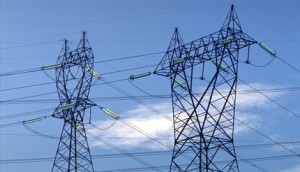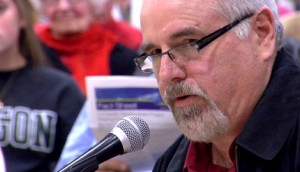The Bonneville Power Administration formally rejected a citizen-proposed route intended to place a 70-mile voltage power line as far away from populated areas of Clark County as possible.
This is the latest chapter in the debate over where BPA should build a new 500-kilovolt transmission line between Castle Rock in Washington and Troutdale in Oregon. The not-for-profit federal agency provides 75 percent of high voltage power in the Northwest. BPA says there hasn’t been a new transmission line in Southwest Washington for 40 years, and one is needed to meet future energy needs in the local area. BPA announced in 2009 that it would begin the process to identify a new corridor, and released its final four alternatives in November 2011.
The line also will be used to exchange power with utilities across the West.

The Bonneville Power Administration is considering four routes for a proposed 500 kilovolt power line, having rejected a fifth route proposed by citizens. Photo courtesy of BPA.
“This is not an power issue, this is a transmission issue,” said BPA spokesperson Doug Johnson. “The issue we face is a constraint with the transmission necessary to get power into this part of the system.”
The agency has selected four official routes for the transmission line and plans to release a draft environmental impact statement (DEIS) with a locally preferred alternative selected this spring.
A western route uses most of an existing transmission corridor that runs parallel to Interstate 5 and into residential areas of Vancouver. Three more easterly alternatives – the Central, East, and Crossover routes – snake through less populated, but heavily forested sections of Clark County. Each route crosses the Columbia River at Camas.
Group charts Grey Line path
Concerned with any transmission line near people, members of the citizen group Another Way BPA charted their own route, calling it the “Grey Line.” Group volunteers drove to sparsely populated areas east of Castle Rock to map out a path that would avoid homes by 500 feet.

Citizen group Another Way BPA unsuccessfully proposed a rural "Grey Line" as a fifth alternative route for BPA's 500-kilovolt transmission route.
They placed much of the line on State Department of Natural Resources (DNR) timberland along the border of Cowlitz and Clark County. They also outlined three different Columbia River crossings: going between Washougal and Camas, using the existing right of ray through Camas, or diverting the line 25 miles east to the Bonneville Dam.
On Wednesday, BPA issued a statement that after examining a modified route which combined the northern section of the Grey Line with the southern section of the East and Crossover lines going through Camas, the new route would cost $30 million more than the next closest alternative (the Central at $407 million), would require up to two years of further environmental study, and would impact more than 200 homes.
Environmental impact concerns
The statement also said the Grey Line posed too great a risk to wetlands and to wildlife, such as spotted owls and bull trout, to be a viable option.
“Considering the results of this study and the significant additional impacts of moving the northern half of the line even farther from populated areas, we have concluded that the suggested corridor offers no significant overall advantage to existing routes proposed from Castle Rock to Troutdale,” wrote BPA project manager Mark Korsness.

Another Way BPA board member Terry Constance wants BPA's transmission line as far from populated areas as possible.
Terry Constance, a board member of Another Way BPA and the one who spearheaded the work on the Grey Line, believes BPA chose environmental concerns over human health.
“Yet again, BPA has elevated owls and eagles’ nests and bull trout over humans,” Constance said. “Humans are more important than any trees or eagles.”
Constance’s group thinks putting such a high-powered transmission line through populated areas poses a health risk due to stronger electromagnetic fields (EMF). He also scoffs at the idea of the Grey Line costing too much, given the likelihood for lawsuits filed by city dwellers angry at having to sell portions of their property as permanent easements to BPA.
“If they made the horrendous decision and they wanted to build it on the right of way, all of that money will be tied up in the courts,” said Constance.
Constance also found BPA’s claim that the Grey Line would harm wetlands and wildlife contradictory. According to BPA’s own studies, each of the four official routes will impact wetlands, streams, high erosion areas, and spotted owl habitats.
“They have to balance themselves and agencies to make people happy and they can’t do it,” he said. “It’s almost an impossible job.”
Property owners opt for status quo
But news that the Grey Line didn’t make the cut pleased at least one citizen group that represents the interest of rural land owners. The group Better Way for BPA says any alternative – including the Grey Line – that runs through the eastern part of the county will encroach on private property. They believe BPA’s best option is to use the existing right of way on the West line, which will claim only 10 miles of private land, as opposed to 48 miles for the Central, 58 miles for the East, and 27 miles for the Crossover route.
“BPA pretty much came to the same conclusion we did,” said Better Way for BPA board member Ray Richards, whose family owns a 360-acre tree farm in the Yale Valley. “We have been advocating for the existing corridor because that has the least impact on people’s property.”
Constance said that it was never his intention to deprive people of their property when he and three other volunteers spent 80 hours mapping out the Grey Line using laptops and GPS coordinates. He admits their top priority was to steer the Grey Line clear of houses or cabins.
They may have been less diligent in determining whether they were on private or public land, but Constance said they were sincere in their attempt.
“We would never purposely impact private property,” he said. “That’s why we went into the field. We spent a lot of time. We are laymen. We are not professionals. It’s not our job to do BPA’s work. BPA has the technology.”

BPA project manager Mark Korsness concluded the Grey Line isn't enough of an improvement over existing alternatives.
BPA’s Doug Johnson says that whichever route BPA selects as the preferred alternative, the other three routes will remain on the table until the final environmental impact statement (FEIS) is reached and the project receives a federal record of decision. He hesitated to predict how long it would take.
“You don’t want to narrow [your options] until you finalize the FEIS,” he said. “We will definitely give residents and everybody on the project to have time to comment.”
As for Constance, he sees BPA as essentially in a no-win situation, but putting the line in densely populated areas is just too risky.
“No matter what the BPA does, someone is going to get impacted,” he said. “If we don’t build on the Grey Line, we can accept that, but we want an unpopulated route.”









